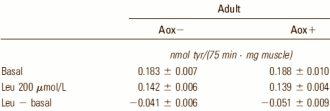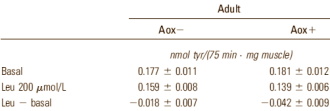|
Definition: "An ergogenic aid is any substance or phenomenon that enhances performance "
|
|
||||||||
29.01.2012 |
|
|
Not so young any more? Leucine still works – with extra antioxidants
Animal studies have shown that long-term supplementation with leucine, an anabolic amino acid, has no effect on the muscle mass of geriatric lab rats. [Nutrition. 2012 Feb;28(2):182-9.] [Age (Dordr). 2011 Apr 7. [Epub ahead of print].] In 2008 researchers at INRA in France did a comparable animal study that revealed how you can get older lab animals – and therefore probably also older humans – to keep on responding to leucine.
The researchers worked with adult rats aged eight months [A] and another group of old rats aged twenty months [O]. In both groups half of the subjects were given ordinary feed [Aox-] for seven weeks. The other half of each group was given food enriched with a mix of vitamin E, vitamin A, zinc, selenium and rutin [Aox+].
Vitamin E and vitamin A are antioxidants. The body needs zinc and selenium for endogenous antioxidants such as the enzymes superoxide-dismutase and glutathione peroxidase to work.
At the end of the seven weeks, the researchers measured how much muscle protein the animals had made in a muscle in the rats' forepaw. They mixed the muscle tissue with the amino acid phenylalanine in a test tube and looked at how fast the tissues absorbed the amino acid. They assumed that the muscle absorbed the amino acid into protein structures. So the uptake is a measure of protein synthesis. At the same time the researchers gave the muscle tissue leucine to boost the protein synthesis.
Leucine has less effect on the muscles of young animals than on those of old animals. However, with antioxidant supplementation the muscles of the older animals became just as sensitive to the anabolic stimulus from the leucine as the muscles of the younger animals.
In the figure below: AAox- = young adult rats, no antioxidant supplementation; AAox+ = young adult rats with antioxidant supplementation; OAox- = old rats, no antioxidant supplementation; OAox+ = old rats with antioxidant supplementation.
The tables below indicate that leucine inhibits protein breakdown in muscles. The more tyrosine 'leaked' out of the muscle fibres, the greater the rate of muscle breakdown. As you can see, the combination of antioxidants and leucine reduced the muscle breakdown in the old rats to the level found in the muscle tissue of the younger rats.
The researchers observed all these interesting effects in test tubes. They even recorded positive effects of the antioxidant mix – the muscles of the older rats that had been given the antioxidant mix had gained a little mass – but these were not statistically significant. "It may be postulated that a longer period of supplementation would be necessary to have a significant effect on muscle mass", the researchers write.
Maybe the researchers should have given their rats extra leucine as well as the antioxidants. Going by their in-vitro studies you'd expect that leucine would enhance the effect of the antioxidants on the older animals.
If other studies confirm the INRA findings, then older strength athletes could get more out of their protein-rich diet by consuming larger amounts of antioxidants. Supplements manufacturers could enrich their protein powders and bars with extra vitamin C, vitamin E, berry extracts or resveratrol.
The researchers do advise caution, however. Before you start taking extra antioxidants you need to know whether they are safe. It's certainly not a good idea to take high concentrations of an antioxidant like vitamin A, or its precursor beta-carotene.
Source:
More:
|
|




